Cite this document
(Banking Industry and Managing Funds Research Paper, n.d.)
Banking Industry and Managing Funds Research Paper. Retrieved from https://studentshare.org/finance-accounting/1746555-a-bold-step-forward-and-what-a-wonderful-world
Banking Industry and Managing Funds Research Paper. Retrieved from https://studentshare.org/finance-accounting/1746555-a-bold-step-forward-and-what-a-wonderful-world
(Banking Industry and Managing Funds Research Paper)
Banking Industry and Managing Funds Research Paper. https://studentshare.org/finance-accounting/1746555-a-bold-step-forward-and-what-a-wonderful-world.
Banking Industry and Managing Funds Research Paper. https://studentshare.org/finance-accounting/1746555-a-bold-step-forward-and-what-a-wonderful-world.
“Banking Industry and Managing Funds Research Paper”, n.d. https://studentshare.org/finance-accounting/1746555-a-bold-step-forward-and-what-a-wonderful-world.


